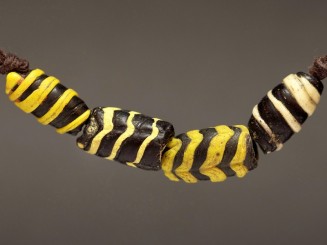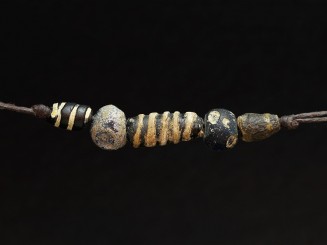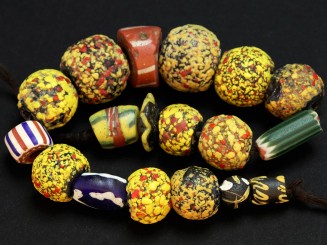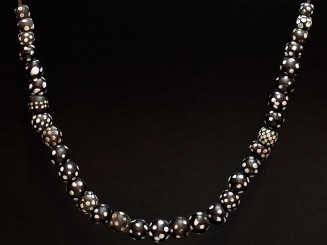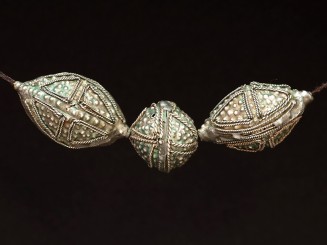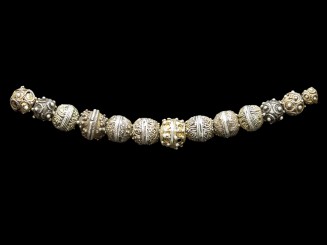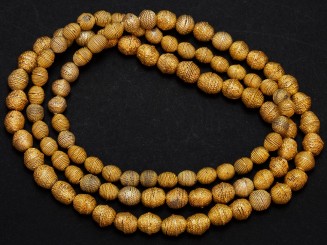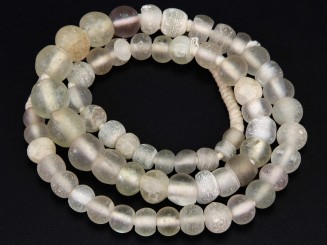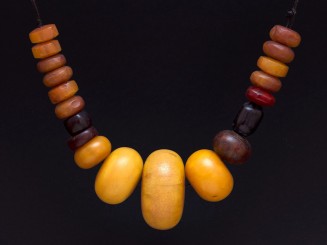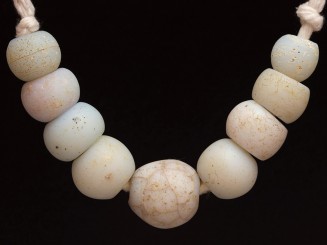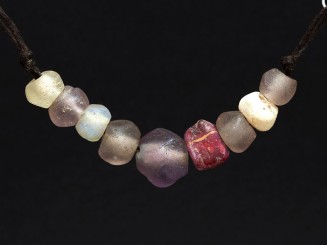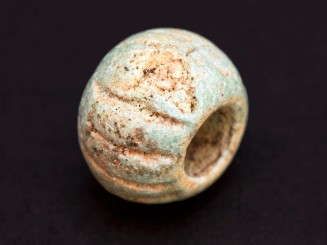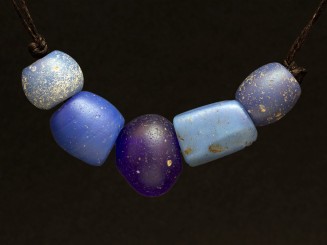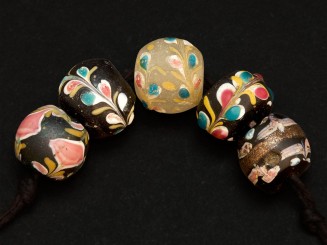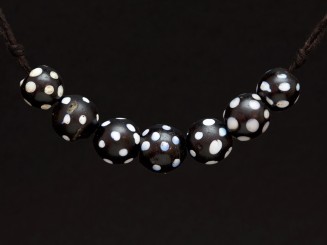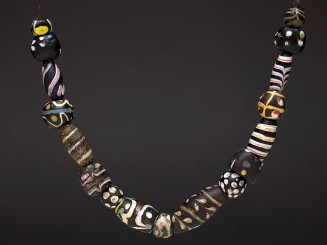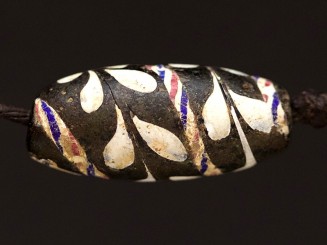Beads
-
Price €36.00MD0316-320
A great set of four ancient Islamic lampwork glass beads featuring a great spiral/feather pattern high relief decoration in a captivating yellow and whitish colors on a great black core. Full of character and showing a great patina considering their age.
The larger bead is approximately 15mm (long) by 9mm (diameter).
When referring to Islamic beads we follow bead expert Robert K. Liu’s description in Ornament Magazine: “The term Islamic Period Glass Beads is used, similarly to Roman Period Beads, to classify groups of ornaments from specific geographic areas and time periods, with recognizable characteristics including patterns and techniques. In the case of Islamic glass beads we know they originated in the Middle East and flourished mostly between the seventh and twelfth centuries. Their designs display a wide mix of techniques and styles: millefiori/mosaic (including pierced mosaic pad beads), trailed, filigreed, combed, fused rods, segmented/blown, folded (an Islamic innovation, Holland and Holland 2006) and those derived from amulet shapes, like charmcase beads with loops.” Islamic glass beads travelled from their sources of production in the Middle and Near East together with the expansion of Islam to North Africa, Southern Europe (Spain), India and the Far East and they reached areas well beyond Islam’s actual limits of expansion such as Northern Europe. They also flowed into Sub-Saharan Africa, where they were valued and cherished for centuries in the Malian ancient kingdoms as a symbol of status and played an important role in the communities’ rites and ceremonies such a burials, initiation or dowries.
Lamp working is one of the main techniques for the making of glass beads. Lamp or lamp work beads were made using glass canes that were reheated to a temperature of up to 1000 ºC by means of a blowtorch or blowlamp and which were then wound onto a coated iron rod to avoid the molten glass from sticking to the metal. The beads produced by the artisan by these means could be then further decorated by re-heating the bead using the same lamp work method and applying colored glass rods or glass cane inserts to the surface of the bead creating an endless variation of patterns and making of each bead one of its own.
-
Price €15.00BC1215-660
Five authentic ancient beads from the Islamic Period (8th to 12th centuries). Three of them showing spiral motif and the other two are eye beads. Marvelous patina after centuries of being buried, including iridescence on one of them.
The central bead measures 20mm long and 8mm in diameter.
When referring to Islamic beads we follow bead expert Robert K. Liu’s description in Ornament Magazine: “The term Islamic Period Glass Beads is used, similarly to Roman Period Beads, to classify groups of ornaments from specific geographic areas and time periods, with recognizable characteristics including patterns and techniques. In the case of Islamic glass beads we know they originated in the Middle East and flourished mostly between the seventh and twelfth centuries. Their designs display a wide mix of techniques and styles: millefiori/mosaic (including pierced mo-saic pad beads), trailed, filigreed, combed, fused rods, segmented/blown, folded (an Islamic inno-vation, Holland and Holland 2006) and those derived from amulet shapes, like charmcase beads with loops.” Islamic glass beads travelled from their sources of production in the Middle and Near East together with the expansion of Islam to North Africa, Southern Europe (Spain), India and the Far East and they reached areas well beyond Islam’s actual limits of expansion such as Northern Europe. They also flowed into Sub-Saharan Africa, where they were valued and cherished for centuries in the Malian ancient kingdoms as a symbol of status and played an important role in the communities’ rites and ceremonies such a burials, initiation or dowries.
-
Price €39.00BC1215-659
A lovely set of eight old translucent glass faceted monochrome beads and a blue oval islamic one. The first would have been produced in the eighteenth century in the city of Amsterdam in order to imitate rock crystal and other precious stones in the trade with the African and American colonies. The red bead with white nucleus could be Venetian. The blue oval one is much older, quite similar beads have been found in fortresses of the Bizantine period in Albania. Beautiful range of colors.
Central oval bead measures 16x11x7mm.
The Dutch beadmaking industry seems to have a short but intense history. Since the SXVI, large quantities of glass beads were produced in the city of Amsterdam thanks to the incorporation of Venetian beadmakers who brought in the necessary techniques and tools to supply Dutch merchants in the incipient trade with the colonies in Africa, Asia and the New World.
We use the term trade beads to refer to the European made glass beads that were used by the European merchants and explorers in the trade in Africa as from the 15th century and continued during their colonial expansion.
The history of trade beads in Africa takes us then to the 15th century and the arrival of the European, mainly the Portuguese, to the coasts of West Africa. The European discovered quite soon how much the people they met there fancied beads and saw they an opportunity for trade. Amongst the beads that captivated the African people most were glass beads since the techniques for their making had not yet been developed locally. The locals fell for the precious and colorful glass beads such as Venetian millefiori or chevron beads that the European traders had on offer and bartered them for commodities such as precious woods, ivory, gold and even used, ignominiously, in the slave trade. The increasing demand in Africa of European made glass beads continued quite until the first half of the 20th century and it had a boosting effect in the production in cities such as Venice which glass beads became very popular and coveted.
-
Price €65.00BC1215-658
A lovely selection of eighteen mixed Venetian trade beads. Circa late 18th to early 20th centuries. Highlights three chevrons and ten “end of the day” beads.
Central bead measures 14mm in diameter
The so called “End of the Day” beads, as the story goes, would be made at the end of the working day by the artisans using the leftovers of other beads made during that day. The result is as pop and modern as you can see.
European glass chevron trade beads were certainly the first to be traded in Africa as early as the 15th century. They show a very characteristic “Rosetta” or “star” layered decoration attained by giving form to glass in a star shaped moulds. Layer after layer are applied to form a cane, which is then cut into cylinders and ground to show the alternated chevron or star layers. They were first produced in the Venetian island of Murano at the Barovier glass factory. The rarest examples are very much coveted and they are quite commonly tagged by the number of layers they show.
We use the term trade beads to refer to the European made glass beads that were used by the European merchants and explorers in the trade in Africa as from the 15th century and continued during their colonial expansion. The history of trade beads in Africa takes us then to the 15th century and the arrival of the European, mainly the Portuguese, to the coasts of West Africa. The European discovered quite soon how much the people they met there fancied beads and saw they an opportunity for trade. Amongst the beads that captivated the African people most were glass beads since the techniques for their making had not yet been developed locally. The locals fell for the precious and colorful glass beads such as Venetian millefiori or chevron beads that the European traders had on offer and bartered them for commodities such as precious woods, ivory, gold and even used, ignominiously, in the slave trade. The increasing demand in Africa of European made glass beads continued quite until the first half of the 20th century and it had a boosting effect in the production in cities such as Venice which glass beads became very popular and coveted.
-
Price €95.00BC1215-657
The model of these thirty-three beautiful Venetian trade beads is without any doubt among those most popular in barter trade in West Africa. They were made at artisan workshops in Venice from the mid-1800s to the first third of the 19th century using the lamp work technique. The very typical eye or dotted decoration classes them as eye beads. The combination of white dots on a black background, though there are other combination of colors, made them known in the trade as “black and white skunk” as they reminded of the fur of this animal. In Spain they where also known as “Moorish” beads and where sometimes found as part of the jewellery arrangements of traditional “charra” jewellery from the province of Salamanca.
The larger bead measures approximately 12mm (long) and 14 mm (diameter).
We use the term trade beads to refer to the European made glass beads that were used by the European merchants and explorers in the trade in Africa as from the 15th century and continued during their colonial expansion. The history of trade beads in Africa takes us then to the 15th century and the arrival of the European, mainly the Portuguese, to the coasts of West Africa. The European discovered quite soon how much the people they met there fancied beads and saw they an opportunity for trade. Amongst the beads that captivated the African people most were glass beads since the techniques for their making had not yet been developed locally. The locals fell for the precious and colorful glass beads such as Venetian millefiori or chevron beads that the European traders had on offer and bartered them for commodities such as precious woods, ivory, gold and even used, ignominiously, in the slave trade. The increasing demand in Africa of European made glass beads continued quite until the first half of the 20th century and it had a boosting effect in the production in cities such as Venice which glass beads became very popular and coveted.
Eye glass beads are beads which main feature are circular decorations that remind of an eye made using lamp work, inset or mosaic techniques. One of the best examples of eye beads are found among Islamic beads mostly blue or green with white eyes as well as eye dotted Venetian glass beads (skunk). The eye decoration may be a simple eye or a number of them scattered on the surface of the bead, they may be plain ones or concentric ones using different colors. Eye beads may also present some linear trails, ziz-zag or floral decoration. Eye beads have been very much valued for centuries, actually they still are, among not only Islamic people but also African people as they were regarded as strong amulets to avert the evil eye and for their alleged prophylactic and magical properties.
Lamp working is one of the main techniques for the making of glass beads. Lamp or lamp work beads were made using glass canes that were reheated to a temperature of up to 1000 ºC by means of a blowtorch or blowlamp and which were then wound onto a coated iron rod to avoid the molten glass from sticking to the metal. The beads produced by the artisan by these means could be then further decorated by re-heating the bead using the same lamp work method and applying colored glass rods or glass cane inserts to the surface of the bead creating an endless variation of patterns and making of each bead one of its own.
-
Price €85.00BC0417-051
Three truly awesome, beautiful and sought after old Mauritanian silver beads (agrabb al-fadda). These beads are hollow and made by welding very thin martelé silver plaques. In this case they also feature a lovely filigree silver lace decoration. Early 20th century.
Central bead measures 17mm in diameter and lateral beads lenght is 28mm.
-
Price €90.00BC0417-049
Thirteen outstanding silver old beads with traces of gilding bath. Featuring an intricate work of granulation and filigree very characteristic of Mauritanians goldsmiths. Very rare to find especially in good condition. Beautiful patina. Beginning of the 20th century or earlier.
Larger bead measures 9mm in diameter and the smallest 5mm.
-
Price €270.00BC0417-048
A Very original set of one hundred and two vintage gilding bath silver beads from the skillful hands of a Mauritanian artisan. Uniques!
Avarage diametre between 5 and 7mm
-
Price €39.00BC0417-047
Three superb vintage biconic gilding bath silver beads from Mauritania. Made by lace filigree. Very original!
Average measures 22mm long by 8mm diameter.
-
Price €66.00BC0417-046
Four beautiful vintage bi-conical tabular gilding bath silver beads featuring granulated filigree work decoration. Very original!
Average size 23x11x6mm
-
Price €350.00BC0417-043
Superb gilding bath silver beads necklace. It features the characteristic and intricate granulated and filigree decoration of the Mauritanian goldsmiths. Second half of the 20th century.
Central bead measures 17mm in diameter and the smallest 7mm.
-
Price €135.00BC0417-041
A superb strand of Dutch glass trade beads popularly called "moon beads" due to the beautiful opalescent reflection they produce to the light. They were among the trade beads produced in the Netherlands in the 18th century and were widely popular among the Dogons in Mali and also in Ethiopia.
The Dutch beadmaking industry seems to have a short but intense history. Since the SXVI, large quantities of glass beads were produced in the city of Amsterdam thanks to the incorporation of Venetian beadmakers who brought in the necessary techniques and tools to supply Dutch merchants in the incipient trade with the colonies in Africa, Asia and the New World.
We use the term trade beads to refer to the European made glass beads that were used by the European merchants and explorers in the trade in Africa as from the 15th century and continued during their colonial expansion.
The history of trade beads in Africa takes us then to the 15th century and the arrival of the European, mainly the Portuguese, to the coasts of West Africa. The European discovered quite soon how much the people they met there fancied beads and saw they an opportunity for trade. Amongst the beads that captivated the African people most were glass beads since the techniques for their making had not yet been developed locally. The locals fell for the precious and colorful glass beads such as Venetian millefiori or chevron beads that the European traders had on offer and bartered them for commodities such as precious woods, ivory, gold and even used, ignominiously, in the slave trade. The increasing demand in Africa of European made glass beads continued quite until the first half of the 20th century and it had a boosting effect in the production in cities such as Venice which glass beads became very popular and coveted.
-
Price €105.00BC0417-040
A very original Mauritanian vintage and old glass, stone and resin beads necklace. Mauritania’s fascination for beads has in this colorful necklace a good example. Venice and Bohemia glass trade beads, outstanding the four small Chevrons. Four beautiful rhomboidal “African amber” resin larger beads, and the triangular central pendant, a most probably Czech imitation in glass of the Idar-Oberstain carnelians.
The triangular central pendant measures 26x27mm
-
Price €149.00BC0417-035
Superb set of 19 phenolic resin beads, bakelite or Catalin, commonly known as "faux amber" or "African amber". They were very popular in the 20s and 30s until the arrival of World War II cut down its production and partly because of that today they are so scarce and appreciated. In Northern and Western Africa they were used as a substitute for amber or Copal in their traditional necklaces. Nice range of ocher and red colors. Notice the twelve hand faceted disk beads.
The large central bead measures 47mm in diameter and 26mm in width. The red disk measures 19x9mm.
-
Price €45.00BC0417-032
A precious set of nine opaque white glass trade beads made in The Netherlands in the 17th century. Popularly known as “Dutch Dogon” due to the fact that this Malian tribe highly used them and would consider them as fertility amulets because of their egg shape. (Dogon eggs)
The central bead measures 24x24mm
These antique wound glass trade beads are commonly known as Dutch Dogon. The reason for that is that they were first made in The Netherlands and it would become extremely popular among the Dogon people in Mali. They are quite large in size and the are usually found in bkue color though they were also made in white, black and brown. The first ones known date as back as the XVIIth century. Very attractive and eye-catching.
The Dutch beadmaking industry seems to have a short but intense history. Since the SXVI, large quantities of glass beads were produced in the city of Amsterdam thanks to the incorporation of Venetian beadmakers who brought in the necessary techniques and tools to supply Dutch merchants in the incipient trade with the colonies in Africa, Asia and the New World.
We use the term trade beads to refer to the European made glass beads that were used by the European merchants and explorers in the trade in Africa as from the 15th century and continued during their colonial expansion.
The history of trade beads in Africa takes us then to the 15th century and the arrival of the European, mainly the Portuguese, to the coasts of West Africa. The European discovered quite soon how much the people they met there fancied beads and saw they an opportunity for trade. Amongst the beads that captivated the African people most were glass beads since the techniques for their making had not yet been developed locally. The locals fell for the precious and colorful glass beads such as Venetian millefiori or chevron beads that the European traders had on offer and bartered them for commodities such as precious woods, ivory, gold and even used, ignominiously, in the slave trade. The increasing demand in Africa of European made glass beads continued quite until the first half of the 20th century and it had a boosting effect in the production in cities such as Venice which glass beads became very popular and coveted.
-
Price €75.00BC0417-031
This is a great set of fourteen antique Islamic glass eye lamp work beads sourced in Mali in the region south of the Niger river between the cities of Mopti and Gao. Though they have been buried for hundreds of years they show a nice condition and a wonderful patina and iridescence. Theire colors range from different shades of blue from dark blue (almost black) to aquamarine. Some of them show some band decoration which adds to their appeal.
The dimensions range from a diameter of 15 mm for the larger bead to 11mm for the smaller one.
When referring to Islamic beads we follow bead expert Robert K. Liu’s description in Ornament Magazine: “The term Islamic Period Glass Beads is used, similarly to Roman Period Beads, to classify groups of ornaments from specific geographic areas and time periods, with recognizable characteristics including patterns and techniques. In the case of Islamic glass beads we know they originated in the Middle East and flourished mostly between the seventh and twelfth centuries. Their designs display a wide mix of techniques and styles: millefiori/mosaic (including pierced mosaic pad beads), trailed, filigreed, combed, fused rods, segmented/blown, folded (an Islamic innovation, Holland and Holland 2006) and those derived from amulet shapes, like charmcase beads with loops.” Islamic glass beads travelled from their sources of production in the Middle and Near East together with the expansion of Islam to North Africa, Southern Europe (Spain), India and the Far East and they reached areas well beyond Islam’s actual limits of expansion such as Northern Europe. They also flowed into Sub-Saharan Africa, where they were valued and cherished for centuries in the Malian ancient kingdoms as a symbol of status and played an important role in the communities’ rites and ceremonies such a burials, initiation or dowries.
Eye glass beads are beads which main feature are circular decorations that remind of an eye made using lamp work, inset or mosaic techniques. One of the best examples of eye beads are found among Islamic beads mostly blue or green with white eyes as well as eye dotted Venetian glass beads (skunk). The eye decoration may be a simple eye or a number of them scattered on the surface of the bead, they may be plain ones or concentric ones using different colors. Eye beads may also present some linear trails, ziz-zag or floral decoration. Eye beads have been very much valued for centuries, actually they still are, among not only Islamic people but also African people as they were regarded as strong amulets to avert the evil eye and for their alleged prophylactic and magical properties.
-
Price €45.00BC0417-030
A precious set of nine old translucent glass faceted monochrome beads. They would have been produced in the eighteenth century by in the city of Amsterdam in order to imitate rock crystal and other precious stones in the trade with the African and American colonies. Notice the red bead with white nucleus that could be Venetian. Beautiful range of mauve colors.
The Dutch beadmaking industry seems to have a short but intense history. Since the SXVI, large quantities of glass beads were produced in the city of Amsterdam thanks to the incorporation of Venetian beadmakers who brought in the necessary techniques and tools to supply Dutch merchants in the incipient trade with the colonies in Africa, Asia and the New World.
We use the term trade beads to refer to the European made glass beads that were used by the European merchants and explorers in the trade in Africa as from the 15th century and continued during their colonial expansion.
The history of trade beads in Africa takes us then to the 15th century and the arrival of the European, mainly the Portuguese, to the coasts of West Africa. The European discovered quite soon how much the people they met there fancied beads and saw they an opportunity for trade. Amongst the beads that captivated the African people most were glass beads since the techniques for their making had not yet been developed locally. The locals fell for the precious and colorful glass beads such as Venetian millefiori or chevron beads that the European traders had on offer and bartered them for commodities such as precious woods, ivory, gold and even used, ignominiously, in the slave trade. The increasing demand in Africa of European made glass beads continued quite until the first half of the 20th century and it had a boosting effect in the production in cities such as Venice which glass beads became very popular and coveted.
-
Price €30.00BC0417-029
A precious ancient turquoise faience bead found on the banks of the Niger River between the cities of Gao and Timbuktu. Its most probable origin is Persia or Egypt, and it would have arrived through the trans-Saharan caravan route at the time of the expansion of Islam. Between the tenth and twelfth centuries.
Faience is a sintered-quartz ceramic displaying surface vitrification which creates a bright lustre of various colours, with blue-green being the most common. Defined as a “material made from powdered quartz covered with a true vitreous coating, usually in a transparent blue or green isotropic glass," faience is distinct from the crystalline compound Egyptian blue. Notably, faience is considerably more porous than glass proper and can be cast in molds to create vessels or objects. Although not properly pottery, as (until late periods) it contains no clay and instead contains the major elemental components of glass (silica), faience is frequently discussed in surveys of ancient pottery, as in stylistic and art-historical terms objects made in it are closer to pottery styles than ancient Egyptian glass.
When referring to Islamic beads we follow bead expert Robert K. Liu’s description in Ornament Magazine: “The term Islamic Period Glass Beads is used, similarly to Roman Period Beads, to classify groups of ornaments from specific geographic areas and time periods, with recognizable characteristics including patterns and techniques. In the case of Islamic glass beads we know they originated in the Middle East and flourished mostly between the seventh and twelfth centuries. Their designs display a wide mix of techniques and styles: millefiori/mosaic (including pierced mo-saic pad beads), trailed, filigreed, combed, fused rods, segmented/blown, folded (an Islamic inno-vation, Holland and Holland 2006) and those derived from amulet shapes, like charmcase beads with loops.” Islamic glass beads travelled from their sources of production in the Middle and Near East together with the expansion of Islam to North Africa, Southern Europe (Spain), India and the Far East and they reached areas well beyond Islam’s actual limits of expansion such as Northern Europe. They also flowed into Sub-Saharan Africa, where they were valued and cherished for centuries in the Malian ancient kingdoms as a symbol of status and played an important role in the communities’ rites and ceremonies such a burials, initiation or dowries.
-
Price €30.00BC0417-027
Five beautiful old glass trade beads made in Europe in the eighteenth century and brought to West Africa for commercial trade. All of them probably Dutch except for the faceted, that would be of Czech manufacture (Bohemia) and popularly known as Russian Blue. These blue beads are very much to the taste of the Dogon people of Mali, where they are among the most precious, due in part to the powers attributed to this color by this culture.
The central bead is 16mm long and 20mm in diameter.
These antique wound glass trade beads are commonly known as Dutch Dogon. The reason for that is that they were first made in The Netherlands and it would become extremely popular among the Dogon people in Mali. They are quite large in size and the are usually found in bkue color though they were also made in white, black and brown. The first ones known date as back as the XVIIth century. Very attractive and eye-catching.
We use the term trade beads to refer to the European made glass beads that were used by the European merchants and explorers in the trade in Africa as from the 15th century and continued during their colonial expansion.
The history of trade beads in Africa takes us then to the 15th century and the arrival of the European, mainly the Portuguese, to the coasts of West Africa. The European discovered quite soon how much the people they met there fancied beads and saw they an opportunity for trade. Amongst the beads that captivated the African people most were glass beads since the techniques for their making had not yet been developed locally. The locals fell for the precious and colorful glass beads such as Venetian millefiori or chevron beads that the European traders had on offer and bartered them for commodities such as precious woods, ivory, gold and even used, ignominiously, in the slave trade. The increasing demand in Africa of European made glass beads continued quite until the first half of the 20th century and it had a boosting effect in the production in cities such as Venice which glass beads became very popular and coveted.
-
Price €45.00BC0417-026
A great set of seven antique Islamic translucent glass beads from the medieval ages in nice shades of blue color. They show a great condition regardless of the fact that they have remained buried for hundreds of years. Found in Mali in the region south of the Niger river between the cities of Mopti and Gao. Three of them are round in shape and the four remaining are oval. Quite similar beads to the latter have been found in fortresses of the Bizantine period in Albania.
The central bead has a diameter of 14mm and the longest one measures 19mm.
When referring to Islamic beads we follow bead expert Robert K. Liu’s description in Ornament Magazine: “The term Islamic Period Glass Beads is used, similarly to Roman Period Beads, to classify groups of ornaments from specific geographic areas and time periods, with recognizable characteristics including patterns and techniques. In the case of Islamic glass beads we know they originated in the Middle East and flourished mostly between the seventh and twelfth centuries. Their designs display a wide mix of techniques and styles: millefiori/mosaic (including pierced mosaic pad beads), trailed, filigreed, combed, fused rods, segmented/blown, folded (an Islamic innovation, Holland and Holland 2006) and those derived from amulet shapes, like charmcase beads with loops.” Islamic glass beads travelled from their sources of production in the Middle and Near East together with the expansion of Islam to North Africa, Southern Europe (Spain), India and the Far East and they reached areas well beyond Islam’s actual limits of expansion such as Northern Europe. They also flowed into Sub-Saharan Africa, where they were valued and cherished for centuries in the Malian ancient kingdoms as a symbol of status and played an important role in the communities’ rites and ceremonies such a burials, initiation or dowries.
-
Price €59.00BC0417-024
Superb six layered rosetta or chevron glass bead produced in Venice at the beginning of the XIX century.
Much apreciated by locals in the Sahara for its magical powers they would never be thrown out and could even be broken in pieces for inheritance distribution purposes. Fortunately this bead still is in pretty good condition.
European glass chevron trade beads were certainly the first to be traded in Africa as early the 15th century. They show a very characteristic “rosetta” o “star” layered decoration attained by giving form to glass in star shaped moulds. Layer after layer are applied to form a cane which is then cut in cylinders and ground to show the alternated chevron or star layers. They were first produced in the Venetian island of Murano at the Barovier glass factory. The rarest examples are very much coveted and they are quite commonly tagged by the number of layers they show.
We use the term trade beads to refer to the European made glass beads that were used by the European merchants and explorers in the trade in Africa as from the 15th century and continued during their colonial expansion. The history of trade beads in Africa takes us then to the 15th century and the arrival of the European, mainly the Portuguese, to the coasts of West Africa. The European discovered quite soon how much the people they met there fancied beads and saw they an opportunity for trade. Amongst the beads that captivated the African people most were glass beads since the techniques for their making had not yet been developed locally. The locals fell for the precious and colorful glass beads such as Venetian millefiori or chevron beads that the European traders had on offer and bartered them for commodities such as precious woods, ivory, gold and even used, ignominiously, in the slave trade. The increasing demand in Africa of European made glass beads continued quite until the first half of the 20th century and it had a boosting effect in the production in cities such as Venice which glass beads became very popular and coveted.
-
Price €59.00BC0417-023
Oh my!. They are so sweet that we cannot but think of candy. A great set of five eye-catching lamp work Venetian fiorà trade beads from the first half of the XIXth century. Their name comes from their characteristic floral or flower decoration that in a captivating array of colors and motifs is distributed on the main body of the bead which, in this particular case, two of them have a solid black body, one translucent bottle green, one with aventurine and the central one of traslucent glass. Very rare to find.
Approximate measures (central bead). 12mm x 13mm.
Also referred to as decorated fancy beads, fiorate or fiorà, these Venetian lamp work glass trade beads are amongst the most attractive we may find. Their main feature is their flamboyant and joyful floral or flower decoration using a rich variety of colors and patterns: feather, bow tie, bouquet, dots, spiral (here we have to mention the well-known Lewis & Clark beads named after the explorers who first traded them with the tribes they found on their expedition from the East to the West coast of the United States in the early 1800s), linear, filigree, etc. They were mainly produced as from the first half of the 19th century. They are usually round or oval shaped.
We use the term trade beads to refer to the European made glass beads that were used by the European merchants and explorers in the trade in Africa as from the 15th century and continued during their colonial expansion.The history of trade beads in Africa takes us then to the 15th century and the arrival of the European, mainly the Portuguese, to the coasts of West Africa. The European discovered quite soon how much the people they met there fancied beads and saw they an opportunity for trade. Amongst the beads that captivated the African people most were glass beads since the techniques for their making had not yet been developed locally. The locals fell for the precious and colorful glass beads such as Venetian millefiori or chevron beads that the European traders had on offer and bartered them for commodities such as precious woods, ivory, gold and even used, ignominiously, in the slave trade. The increasing demand in Africa of European made glass beads continued quite until the first half of the 20th century and it had a boosting effect in the production in cities such as Venice which glass beads became very popular and coveted.
-
Price €42.00BC0417-022
The model of these beautiful Venetian trade beads is without any doubt among those most popular in barter trade in West Africa. They were made at artisan workshops in Venice from the mid-1800s to the first third of the 19th century using the lamp work technique. The very typical eye or dotted decoration classes them as eye beads. The combination of white dots on a black background, though there are other combination of colors, made them known in the trade as “black and white skunk” as they reminded of the fur of this animal. In Spain they where also known as “Moorish” beads and where sometimes found as part of the jewellery arrangements of traditional “charra” jewellery from the province of Salamanca.
Average diameter Ø12mm
We use the term trade beads to refer to the European made glass beads that were used by the European merchants and explorers in the trade in Africa as from the 15th century and continued during their colonial expansion. The history of trade beads in Africa takes us then to the 15th century and the arrival of the European, mainly the Portuguese, to the coasts of West Africa. The European discovered quite soon how much the people they met there fancied beads and saw they an opportunity for trade. Amongst the beads that captivated the African people most were glass beads since the techniques for their making had not yet been developed locally. The locals fell for the precious and colorful glass beads such as Venetian millefiori or chevron beads that the European traders had on offer and bartered them for commodities such as precious woods, ivory, gold and even used, ignominiously, in the slave trade. The increasing demand in Africa of European made glass beads continued quite until the first half of the 20th century and it had a boosting effect in the production in cities such as Venice which glass beads became very popular and coveted.
Eye glass beads are beads which main feature are circular decorations that remind of an eye made using lamp work, inset or mosaic techniques. One of the best examples of eye beads are found among Islamic beads mostly blue or green with white eyes as well as eye dotted Venetian glass beads (skunk). The eye decoration may be a simple eye or a number of them scattered on the surface of the bead, they may be plain ones or concentric ones using different colors. Eye beads may also present some linear trails, ziz-zag or floral decoration. Eye beads have been very much valued for centuries, actually they still are, among not only Islamic people but also African people as they were regarded as strong amulets to avert the evil eye and for their alleged prophylactic and magical properties.
Lamp working is one of the main techniques for the making of glass beads. Lamp or lamp work beads were made using glass canes that were reheated to a temperature of up to 1000 ºC by means of a blowtorch or blowlamp and which were then wound onto a coated iron rod to avoid the molten glass from sticking to the metal. The beads produced by the artisan by these means could be then further decorated by re-heating the bead using the same lamp work method and applying colored glass rods or glass cane inserts to the surface of the bead creating an endless variation of patterns and making of each bead one of its own.
-
Price €75.00BC0417-021
A lovely set of twentyfive old glass beads. This successful selection combines different types of old Venetian trade beads among which we find practically one of each type; eye, spiral, feather, fiorà, etc. from the XIX and XX centuries.
Larger bead measure: 19mm long, 10mm diameter
We use the term trade beads to refer to the European made glass beads that were used by the European merchants and explorers in the trade in Africa as from the 15th century and continued during their colonial expansion. The history of trade beads in Africa takes us then to the 15th century and the arrival of the European, mainly the Portuguese, to the coasts of West Africa. The European discovered quite soon how much the people they met there fancied beads and saw they an opportunity for trade. Amongst the beads that captivated the African people most were glass beads since the techniques for their making had not yet been developed locally. The locals fell for the precious and colorful glass beads such as Venetian millefiori or chevron beads that the European traders had on offer and bartered them for commodities such as precious woods, ivory, gold and even used, ignominiously, in the slave trade. The increasing demand in Africa of European made glass beads continued quite until the first half of the 20th century and it had a boosting effect in the production in cities such as Venice which glass beads became very popular and coveted.
Lamp working is one of the main techniques for the making of glass beads. Lamp or lamp work beads were made using glass canes that were reheated to a temperature of up to 1000 ºC by means of a blowtorch or blowlamp and which were then wound onto a coated iron rod to avoid the molten glass from sticking to the metal. The beads produced by the artisan by these means could be then further decorated by re-heating the bead using the same lamp work method and applying colored glass rods or glass cane inserts to the surface of the bead creating an endless variation of patterns and making of each bead one of its own.
When referring to Islamic beads we follow bead expert Robert K. Liu’s description in Ornament Magazine: “The term Islamic Period Glass Beads is used, similarly to Roman Period Beads, to classify groups of ornaments from specific geographic areas and time periods, with recognizable characteristics including patterns and techniques. In the case of Islamic glass beads we know they originated in the Middle East and flourished mostly between the seventh and twelfth centuries. Their designs display a wide mix of techniques and styles: millefiori/mosaic (including pierced mosaic pad beads), trailed, filigreed, combed, fused rods, segmented/blown, folded (an Islamic innovation, Holland and Holland 2006) and those derived from amulet shapes, like charmcase beads with loops.” Islamic glass beads travelled from their sources of production in the Middle and Near East together with the expansion of Islam to North Africa, Southern Europe (Spain), India and the Far East and they reached areas well beyond Islam’s actual limits of expansion such as Northern Europe. They also flowed into Sub-Saharan Africa, where they were valued and cherished for centuries in the Malian ancient kingdoms as a symbol of status and played an important role in the communities’ rites and ceremonies such a burials, initiation or dowries.
-
Price €95.00BC1215-656
A lovely set of seventeen old and ancient glass beads. This successful selection combines different types of Venetian trade beads and three small Islamic beads, the central one and those of the extremes. Among the Venetians we find practically one of each type; eye, spiral, feather, fioré, Lewis & Clark, with aventurine, etc.
Among the Islamic highlights the central eye bead with a beautiful patina of remnants of layering or iridescence due to centuries of contact with the earth. On the right end a three faces bead and on the left end a beautiful feather one.
Larger bead measure: 26mm long, 11mm diameter
We use the term trade beads to refer to the European made glass beads that were used by the European merchants and explorers in the trade in Africa as from the 15th century and continued during their colonial expansion. The history of trade beads in Africa takes us then to the 15th century and the arrival of the European, mainly the Portuguese, to the coasts of West Africa. The European discovered quite soon how much the people they met there fancied beads and saw they an opportunity for trade. Amongst the beads that captivated the African people most were glass beads since the techniques for their making had not yet been developed locally. The locals fell for the precious and colorful glass beads such as Venetian millefiori or chevron beads that the European traders had on offer and bartered them for commodities such as precious woods, ivory, gold and even used, ignominiously, in the slave trade. The increasing demand in Africa of European made glass beads continued quite until the first half of the 20th century and it had a boosting effect in the production in cities such as Venice which glass beads became very popular and coveted.
Lamp working is one of the main techniques for the making of glass beads. Lamp or lamp work beads were made using glass canes that were reheated to a temperature of up to 1000 ºC by means of a blowtorch or blowlamp and which were then wound onto a coated iron rod to avoid the molten glass from sticking to the metal. The beads produced by the artisan by these means could be then further decorated by re-heating the bead using the same lamp work method and applying colored glass rods or glass cane inserts to the surface of the bead creating an endless variation of patterns and making of each bead one of its own.
When referring to Islamic beads we follow bead expert Robert K. Liu’s description in Ornament Magazine: “The term Islamic Period Glass Beads is used, similarly to Roman Period Beads, to classify groups of ornaments from specific geographic areas and time periods, with recognizable characteristics including patterns and techniques. In the case of Islamic glass beads we know they originated in the Middle East and flourished mostly between the seventh and twelfth centuries. Their designs display a wide mix of techniques and styles: millefiori/mosaic (including pierced mosaic pad beads), trailed, filigreed, combed, fused rods, segmented/blown, folded (an Islamic innovation, Holland and Holland 2006) and those derived from amulet shapes, like charmcase beads with loops.” Islamic glass beads travelled from their sources of production in the Middle and Near East together with the expansion of Islam to North Africa, Southern Europe (Spain), India and the Far East and they reached areas well beyond Islam’s actual limits of expansion such as Northern Europe. They also flowed into Sub-Saharan Africa, where they were valued and cherished for centuries in the Malian ancient kingdoms as a symbol of status and played an important role in the communities’ rites and ceremonies such a burials, initiation or dowries.
-
Price €80.00BC1215-655
A superb set of nine Venetian trade lamp work glass beads commonly known as “Blue skunk”. These are among the rarest and oldest of their kind as they were made as from the very early years of the XIXth century in Venice. The very typical eye or dotted decoration classes them as eye beads. These ones are particularly valued as their fabrication required a high degree of dexterity to decorate each white eye with a blue translucent eye on relief on top which, besides, made them very sensible to wear and damage.
Approximate measures of larger bead: 13mm (long), 15mm (diameter).
We use the term trade beads to refer to the European made glass beads that were used by the European merchants and explorers in the trade in Africa as from the 15th century and continued during their colonial expansion. The history of trade beads in Africa takes us then to the 15th century and the arrival of the European, mainly the Portuguese, to the coasts of West Africa. The European discovered quite soon how much the people they met there fancied beads and saw they an opportunity for trade. Amongst the beads that captivated the African people most were glass beads since the techniques for their making had not yet been developed locally. The locals fell for the precious and colorful glass beads such as Venetian millefiori or chevron beads that the European traders had on offer and bartered them for commodities such as precious woods, ivory, gold and even used, ignominiously, in the slave trade. The increasing demand in Africa of European made glass beads continued quite until the first half of the 20th century and it had a boosting effect in the production in cities such as Venice which glass beads became very popular and coveted.
Eye glass beads are beads which main feature are circular decorations that remind of an eye made using lamp work, inset or mosaic techniques. One of the best examples of eye beads are found among Islamic beads mostly blue or green with white eyes as well as eye dotted Venetian glass beads (skunk). The eye decoration may be a simple eye or a number of them scattered on the surface of the bead, they may be plain ones or concentric ones using different colors. Eye beads may also present some linear trails, ziz-zag or floral decoration. Eye beads have been very much valued for centuries, actually they still are, among not only Islamic people but also African people as they were regarded as strong amulets to avert the evil eye and for their alleged prophylactic and magical properties.
Lamp working is one of the main techniques for the making of glass beads. Lamp or lamp work beads were made using glass canes that were reheated to a temperature of up to 1000 ºC by means of a blowtorch or blowlamp and which were then wound onto a coated iron rod to avoid the molten glass from sticking to the metal. The beads produced by the artisan by these means could be then further decorated by re-heating the bead using the same lamp work method and applying colored glass rods or glass cane inserts to the surface of the bead creating an endless variation of patterns and making of each bead one of its own.
-
Price €24.00BC1215-654
A beautiful lamp work Venetian trade bead from the first half of the XIXth century. This type of beads are usually labelled as floral fancy decorated beads (fiorate or fiorà) due to its decorative motifs resembling flowers and branches. These particular ones are commonly known as "Lewis & Clark" beads as the first reference known of them being used in the trade are that of early American explorers, Meriwether Lewis and William Clark, who with their native guide Sacagawea went on a famous expedition from the east to the west coast of America on the very early years of the XIXth century.
Approximate measures: 26mm (long), 11mm (diameter).
We use the term trade beads to refer to the European made glass beads that were used by the European merchants and explorers in the trade in Africa as from the 15th century and continued during their colonial expansion. The history of trade beads in Africa takes us then to the 15th century and the arrival of the European, mainly the Portuguese, to the coasts of West Africa. The European discovered quite soon how much the people they met there fancied beads and saw they an opportunity for trade. Amongst the beads that captivated the African people most were glass beads since the techniques for their making had not yet been developed locally. The locals fell for the precious and colorful glass beads such as Venetian millefiori or chevron beads that the European traders had on offer and bartered them for commodities such as precious woods, ivory, gold and even used, ignominiously, in the slave trade. The increasing demand in Africa of European made glass beads continued quite until the first half of the 20th century and it had a boosting effect in the production in cities such as Venice which glass beads became very popular and coveted.
Lamp working is one of the main techniques for the making of glass beads. Lamp or lamp work beads were made using glass canes that were reheated to a temperature of up to 1000 ºC by means of a blowtorch or blowlamp and which were then wound onto a coated iron rod to avoid the molten glass from sticking to the metal. The beads produced by the artisan by these means could be then further decorated by re-heating the bead using the same lamp work method and applying colored glass rods or glass cane inserts to the surface of the bead creating an endless variation of patterns and making of each bead one of its own.
-
Price €39.00BC1215-653
Oh my!. They are so sweet that we cannot but think of candy. A great set of three eye-catching lamp work Venetian fiorà trade beads from the first half of the XIXth century. Their name comes from their characteristic floral or flower decoration that in a captivating array of colors and motifs is distributed on the main body of the bead which, in this particular case, is of a nice translucent red color which allows to see the main white core of the beads (white hearts) and the central one of traslucent glass. Very rare to find.
Approximate measures (central bead). 12mm x 14mm.
Also referred to as decorated fancy beads, fiorate or fiorà, these Venetian lamp work glass trade beads are amongst the most attractive we may find. Their main feature is their flamboyant and joyful floral or flower decoration using a rich variety of colors and patterns: feather, bow tie, bouquet, dots, spiral (here we have to mention the well-known Lewis & Clark beads named after the explorers who first traded them with the tribes they found on their expedition from the East to the West coast of the United States in the early 1800s), linear, filigree, etc. They were mainly produced as from the first half of the 19th century. They are usually round or oval shaped.
We use the term trade beads to refer to the European made glass beads that were used by the European merchants and explorers in the trade in Africa as from the 15th century and continued during their colonial expansion.The history of trade beads in Africa takes us then to the 15th century and the arrival of the European, mainly the Portuguese, to the coasts of West Africa. The European discovered quite soon how much the people they met there fancied beads and saw they an opportunity for trade. Amongst the beads that captivated the African people most were glass beads since the techniques for their making had not yet been developed locally. The locals fell for the precious and colorful glass beads such as Venetian millefiori or chevron beads that the European traders had on offer and bartered them for commodities such as precious woods, ivory, gold and even used, ignominiously, in the slave trade. The increasing demand in Africa of European made glass beads continued quite until the first half of the 20th century and it had a boosting effect in the production in cities such as Venice which glass beads became very popular and coveted.
-
Price €48.00BC1215-652
A set of four joyful lamp work Venetian fiorà trade beads from the first half of the XIXth century. Their name comes from their characteristic floral or flower decoration that in a captivating array of colors and motifs is distributed on the main body of the bead which, in this particular case, is of a nice opaque black color.
Approximate dimensions (larger bead): 12mm x Ø14mm.
Also referred to as decorated fancy beads, fiorate or fiorà, these Venetian lamp work glass trade beads are amongst the most attractive we may find. Their main feature is their flamboyant and joyful floral or flower decoration using a rich variety of colors and patterns: feather, bow tie, bouquet, dots, spiral (here we have to mention the well-known Lewis & Clark beads named after the explorers who first traded them with the tribes they found on their expedition from the East to the West coast of the United States in the early 1800s), linear, filigree, etc. They were mainly produced as from the first half of the 19th century. They are usually round or oval shaped.
We use the term trade beads to refer to the European made glass beads that were used by the European merchants and explorers in the trade in Africa as from the 15th century and continued during their colonial expansion.The history of trade beads in Africa takes us then to the 15th century and the arrival of the European, mainly the Portuguese, to the coasts of West Africa. The European discovered quite soon how much the people they met there fancied beads and saw they an opportunity for trade. Amongst the beads that captivated the African people most were glass beads since the techniques for their making had not yet been developed locally. The locals fell for the precious and colorful glass beads such as Venetian millefiori or chevron beads that the European traders had on offer and bartered them for commodities such as precious woods, ivory, gold and even used, ignominiously, in the slave trade. The increasing demand in Africa of European made glass beads continued quite until the first half of the 20th century and it had a boosting effect in the production in cities such as Venice which glass beads became very popular and coveted.
-
Price €60.00BC1215-651
This eye-catching lampwork Venetian trade glass beads were made in the mid-1800s. Their decoration combines linear motifs conforming a grid pattern and little “eyes” or dots for which the can be tagged as eye-beads. On the other hand the combination of that grid pattern and the dots have made them to be sometimes referred in the trade as “pineapple” beads. The main body of the beads is of a great dark green color.
Approximate measures (central bead): 17 mm (long), 10 mm (diameter).
We use the term trade beads to refer to the European made glass beads that were used by the European merchants and explorers in the trade in Africa as from the 15th century and continued during their colonial expansion. The history of trade beads in Africa takes us then to the 15th century and the arrival of the European, mainly the Portuguese, to the coasts of West Africa. The European discovered quite soon how much the people they met there fancied beads and saw they an opportunity for trade. Amongst the beads that captivated the African people most were glass beads since the techniques for their making had not yet been developed locally. The locals fell for the precious and colorful glass beads such as Venetian millefiori or chevron beads that the European traders had on offer and bartered them for commodities such as precious woods, ivory, gold and even used, ignominiously, in the slave trade. The increasing demand in Africa of European made glass beads continued quite until the first half of the 20th century and it had a boosting effect in the production in cities such as Venice which glass beads became very popular and coveted.
Eye glass trade beads are beads which main feature are circular decorations that remind of an eye made using lamp work, inset or mosaic techniques. One of the best examples of eye beads are found among Islamic beads mostly blue or green with white eyes as well as eye dotted Venetian glass beads (skunk). The eye decoration may be a simple eye or a number of them scattered on the surface of the bead, they may be plain ones or concentric ones using different colors. Eye beads may also present some linear trails, ziz-zag or floral decoration. Eye beads have been very much valued for centuries, actually they still are, among not only Islamic people but also African people as they were regarded as strong amulets to avert the evil eye and for their alleged prophylactic and magical properties.
Lamp working is one of the main techniques for the making of glass beads. Lamp or lamp work beads were made using glass canes that were reheated to a temperature of up to 1000 ºC by means of a blowtorch or blowlamp and which were then wound onto a coated iron rod to avoid the molten glass from sticking to the metal. The beads produced by the artisan by these means could be then further decorated by re-heating the bead using the same lamp work method and applying colored glass rods or glass cane inserts to the surface of the bead creating an endless variation of patterns and making of each bead one of its own.
-
Price €108.00BC1215-650
We can think of Alice wandering Wonderland wearing a necklace made of a combination of these awesome glass beads. This is a set of nine superb lamp work Venetian fiorà trade beads from the first half of the XIXth century. Their name comes from their characteristic floral or flower decoration that in a captivating array of colors (pink, yellow, white-lattimo) and motifs is distributed on the main body of the bead which, in this particular case, is of a nice dark green color or black.
Approximate measures (larger bead): 12mm x 14mm.
Also referred to as decorated fancy beads, fiorate or fiorà, these Venetian lamp work glass trade beads are amongst the most attractive we may find. Their main feature is their flamboyant and joyful floral or flower decoration using a rich variety of colors and patterns: feather, bow tie, bouquet, dots, spiral (here we have to mention the well-known Lewis & Clark beads named after the explorers who first traded them with the tribes they found on their expedition from the East to the West coast of the United States in the early 1800s), linear, filigree, etc. They were mainly produced as from the first half of the 19th century. They are usually round or oval shaped.
We use the term trade beads to refer to the European made glass beads that were used by the European merchants and explorers in the trade in Africa as from the 15th century and continued during their colonial expansion.The history of trade beads in Africa takes us then to the 15th century and the arrival of the European, mainly the Portuguese, to the coasts of West Africa. The European discovered quite soon how much the people they met there fancied beads and saw they an opportunity for trade. Amongst the beads that captivated the African people most were glass beads since the techniques for their making had not yet been developed locally. The locals fell for the precious and colorful glass beads such as Venetian millefiori or chevron beads that the European traders had on offer and bartered them for commodities such as precious woods, ivory, gold and even used, ignominiously, in the slave trade. The increasing demand in Africa of European made glass beads continued quite until the first half of the 20th century and it had a boosting effect in the production in cities such as Venice which glass beads became very popular and coveted.
-
Price €265.00AC0616-638
A superb strand of sixty eight trade glass biconical beads, most of them are “eye beads” inspired on the much more ancient Islamic type, and five of them with linear decoration are the so called “King beads” by English merchants or Gololo by West Africans. These types of beads were made in Venice as from the beginning of the XIXth century using the lamp work technique. They were made in a variety of colors combining an opaque glass, solid color core (yellow, burgundy, black, green, etc.). These beads were among the most important ones in the gold trade in Africa.
The biggest bead is 16mm long and 23mm diameter and the smallest 10mm by 12mm.
We use the term trade beads to refer to the European made glass beads that were used by the European merchants and explorers in the trade in Africa as from the 15th century and continued during their colonial expansion. The history of trade beads in Africa takes us then to the 15th century and the arrival of the European, mainly the Portuguese, to the coasts of West Africa. The European discovered quite soon how much the people they met there fancied beads and saw they an opportunity for trade. Amongst the beads that captivated the African people most were glass beads since the techniques for their making had not yet been developed locally. The locals fell for the precious and colorful glass beads such as Venetian millefiori or chevron beads that the European traders had on offer and bartered them for commodities such as precious woods, ivory, gold and even used, ignominiously, in the slave trade. The increasing demand in Africa of European made glass beads continued quite until the first half of the 20th century and it had a boosting effect in the production in cities such as Venice which glass beads became very popular and coveted.
Lamp working is one of the main techniques for the making of glass beads. Lamp or lamp work beads were made using glass canes that were reheated to a temperature of up to 1000 ºC by means of a blowtorch or blowlamp and which were then wound onto a coated iron rod to avoid the molten glass from sticking to the metal. The beads produced by the artisan by these means could be then further decorated by re-heating the bead using the same lamp work method and applying colored glass rods or glass cane inserts to the surface of the bead creating an endless variation of patterns and making of each bead one of its own.
-
Price €265.00AC0616-637
Lovely strand of fifty seven trade glass biconical beads. These type of beads were made in Venice as from the beginning of the XIXth century using the lamp work technique. They were made in a variety of colors combining a opaque glass solid color core (yellow, burgundy, black, green, etc) on which linear decoration was applied in a lively combination of colors. These beads were known in the trade a “King beads” and also, locally, as Gololo beads. These beads were among the most important ones in the gold trade in Africa.
The biggest bead is 20mm long and 22mm diameter and the smallest 12mm by 13mm.
We use the term trade beads to refer to the European made glass beads that were used by the European merchants and explorers in the trade in Africa as from the 15th century and continued during their colonial expansion. The history of trade beads in Africa takes us then to the 15th century and the arrival of the European, mainly the Portuguese, to the coasts of West Africa. The European discovered quite soon how much the people they met there fancied beads and saw they an opportunity for trade. Amongst the beads that captivated the African people most were glass beads since the techniques for their making had not yet been developed locally. The locals fell for the precious and colorful glass beads such as Venetian millefiori or chevron beads that the European traders had on offer and bartered them for commodities such as precious woods, ivory, gold and even used, ignominiously, in the slave trade. The increasing demand in Africa of European made glass beads continued quite until the first half of the 20th century and it had a boosting effect in the production in cities such as Venice which glass beads became very popular and coveted.
Lamp working is one of the main techniques for the making of glass beads. Lamp or lamp work beads were made using glass canes that were reheated to a temperature of up to 1000 ºC by means of a blowtorch or blowlamp and which were then wound onto a coated iron rod to avoid the molten glass from sticking to the metal. The beads produced by the artisan by these means could be then further decorated by re-heating the bead using the same lamp work method and applying colored glass rods or glass cane inserts to the surface of the bead creating an endless variation of patterns and making of each bead one of its own.
-
Price €265.00AC0616-636
Lovely strand of sixty three trade glass biconical beads. These type of beads were made in Venice as from the beginning of the XIXth century using the lamp work technique. They were made in a variety of colors combining a opaque glass solid color core (yellow, burgundy, black, green, etc) on which linear decoration was applied in a lively combination of colors. These beads were known in the trade a “King beads” and also, locally, as Gololo beads. These beads were among the most important ones in the gold trade in Africa.
The biggest bead is 16mm long and 18mm diameter and the smallest 12mm by 12mm.
We use the term trade beads to refer to the European made glass beads that were used by the European merchants and explorers in the trade in Africa as from the 15th century and continued during their colonial expansion. The history of trade beads in Africa takes us then to the 15th century and the arrival of the European, mainly the Portuguese, to the coasts of West Africa. The European discovered quite soon how much the people they met there fancied beads and saw they an opportunity for trade. Amongst the beads that captivated the African people most were glass beads since the techniques for their making had not yet been developed locally. The locals fell for the precious and colorful glass beads such as Venetian millefiori or chevron beads that the European traders had on offer and bartered them for commodities such as precious woods, ivory, gold and even used, ignominiously, in the slave trade. The increasing demand in Africa of European made glass beads continued quite until the first half of the 20th century and it had a boosting effect in the production in cities such as Venice which glass beads became very popular and coveted.
Lamp working is one of the main techniques for the making of glass beads. Lamp or lamp work beads were made using glass canes that were reheated to a temperature of up to 1000 ºC by means of a blowtorch or blowlamp and which were then wound onto a coated iron rod to avoid the molten glass from sticking to the metal. The beads produced by the artisan by these means could be then further decorated by re-heating the bead using the same lamp work method and applying colored glass rods or glass cane inserts to the surface of the bead creating an endless variation of patterns and making of each bead one of its own.
-
Price €560.00AC0616-635
A superb collection of fifty-six rosetta or chevron glass beads of two, three and four layers made with star-shaped cross section cane insets with external stripes in two and three colors and in some cases finished with a final layer of transparent glass. These beads were manufactured in Venice from the early nineteenth century and would have been employed in West Africa in the trade of gold and palm oil.
The largest of the beads is 17mm in diameter and 15mm in length and the smallest is 8 by 8mm.
European glass chevron trade beads were certainly the first to be traded in Africa as early the 15th century. They show a very characteristic “rosetta” o “star” layered decoration attained by giving form to glass in star shaped moulds. Layer after layer are applied to form a cane which is then cut in cylinders and ground to show the alternated chevron or star layers. They were first produced in the Venetian island of Murano at the Barovier glass factory. The rarest examples are very much coveted and they are quite commonly tagged by the number of layers they show.
We use the term trade beads to refer to the European made glass beads that were used by the European merchants and explorers in the trade in Africa as from the 15th century and continued during their colonial expansion. The history of trade beads in Africa takes us then to the 15th century and the arrival of the European, mainly the Portuguese, to the coasts of West Africa. The European discovered quite soon how much the people they met there fancied beads and saw they an opportunity for trade. Amongst the beads that captivated the African people most were glass beads since the techniques for their making had not yet been developed locally. The locals fell for the precious and colorful glass beads such as Venetian millefiori or chevron beads that the European traders had on offer and bartered them for commodities such as precious woods, ivory, gold and even used, ignominiously, in the slave trade. The increasing demand in Africa of European made glass beads continued quite until the first half of the 20th century and it had a boosting effect in the production in cities such as Venice which glass beads became very popular and coveted.
-
Price €39.00MA0905-740
A lovely Moroccan Berber old silver plaque with beatiful incise decoration. Pieces like these were sewn in rows on textile or leather pieces making beautiful headbands. They were often combined with some other elements such as coral, amzonite, silver coins, trade beads to a most flamboyant result.

